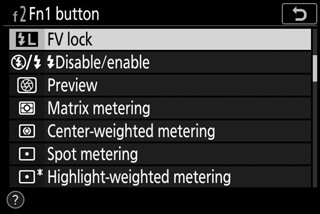FV Lock
This feature is used to lock flash output, allowing photographs to be recomposed without changing the flash level and ensuring that flash output is appropriate to the subject even when the subject is not positioned in the center of the frame. Flash output is adjusted automatically for any changes in ISO sensitivity and aperture. FV lock is not available in b mode.
To use FV lock:
-
Assign FV lock to a camera control.
Assign FV lock to a control using Custom Setting f2 (Custom control assignment).

-
Attach a CLS-compatible flash unit.
Mount a CLS-compatible flash unit on the camera accessory shoe.
-
Set the flash unit to the appropriate mode.
Turn the flash unit on and select TTL or Auto external flash for Flash control > Flash control mode (SB-5000, SB-500, SB-400, or SB-300) or set the flash control mode to TTL, monitor pre-flash qA, or monitor pre-flash A (other flash units; see the documentation provided with the flash unit for details).
-
Focus.
Position the subject in the center of the frame and press the shutter-release button halfway to focus.


-
Lock flash level.
After confirming that the flash-ready indicator (c) appears in the camera display, press the control selected in Step 1. The flash unit will emit a monitor pre-flash to determine the appropriate flash level. Flash output will be locked at this level and FV lock icon (r) will appear in the camera display.

-
Recompose the photograph.
Flash output will remain locked at the value metered in Step 5.

-
Take the photograph.
Press the shutter-release button the rest of the way down to shoot. If desired, additional pictures can be taken without releasing FV lock.
-
Release FV lock.
Press the control selected in Step 1 to release FV lock. Confirm that the FV lock icon (r) is no longer displayed.
